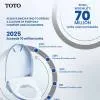It speaks for itself when the 108th Nobel prize in physiology was awarded to a trio of American scientists for their discoveries on the molecular mechanisms controlling circadian rhythms—in other words, the 24-hour body clock. Maintaining our body clock helps regulate sleep patterns, feeding behaviour, hormone release and blood pressure. Light, more specifically daylight, has a significant influence on our body clock and thus on circadian rhythm. In simple terms, our body’s circadian system is a blue sky detector. Exposure to lots of blue light tells the body to be awake and alert. As we are aware, the dominant colour of the sky and daytime sunlight is blue and shorter wavelength blue light has a greater impact on our circadian system than long wavelength red or warm light.

Circadian rhythm is our body’s internal alarm clock that tells us when it’s naturally time to wake up in the morning and get sleep at night. This internal clock in humans has a period that is on average slightly longer than 24 hours, and thus average adults require the phase and period of their internal clock to be reset on a daily basis to remain entrained to the 24-hour day. Light, and blulight in particular, is the dominant environmental time cue that entrains the human circadian clock to the 24-hour day, and the timing of light exposure will determine whether the internal clock is phase delayed or advanced.
We need a cool white light with a high blue content and high illuminance to remain more alert and active during the day. We need warm white light with greater red content in evenings to have a good quality of sleep. We wake up with daylight and sleep with sundown. Light plays a larger role in our daily lives beyond its function to allow us to see objects.
Right light: Beyond enabling vision
Enabling vision is a primary objective of light. Light also has a major role in controlling body’s circadian rhythm, which is a non-visual but important function. While the presence or absence of daylight can largely influence the circadian rhythm, artificial or electric lighting can also mimic natural light to a certain extent and offer the benefits of natural light.
Lighting specifications and requirements that impact circadian systems are different than those effective for visual comfort only. The understanding of quantity, spectrum, time of day, duration of lighting and distribution is critical to the design of circadian lighting.
Typically, in the absence of daylight, electric lighting with cool, light levels for high circadian impact is recommended during daytime and warm lowlight levels for reduced circadian impact are recommended prior to sleep time in evenings, for appropriate circadian control.
Thus far, the discourse on good and green lighting design focused on design parameters such as illumination level on horizontal work plane, energy-efficiency of light source, uniformity of lighting, colour temperature and colour rendering index choice of luminaires for proper distribution.
Lighting for circadian entrainment or human-centric lighting has added design and controllability requirements.
Lighting parameters affecting the circadian system, as measured by acute melatonin suppression and phase shifting of melatonin onset in evening when melatonin levels rise, are different from there that impact visibility.
While rods and cones are photoreceptors that help us with vision, there is a set of third photoreceptors, namely IPRGCs, which are critical to the circadian system of our body.
These photoreceptors are sensitive to teal blue light (480 nm). They measure the amount of blue light and help our body to sense the time of day. They are connected to the part of our brain called suprachiasmatic nucleus (SCN), where our body’s master clock is located. SCN works with the pineal gland and other hormone systems to regulate our circadian rhythms and hormone cycles and, in turn, regulate many physiological pressures in our body such as alertness, digestion and sleep. Over exposure to blue light in evening disrupts melatonin hormone production and in turn disrupts our sleep-wake cycle, thus directly impacting our health and productivity at work.
A dynamic lighting system, which has a blend of right light with desirable spectral distribution, luminaire for proper distribution in horizontal and vertical planes and intelligent controls, is needed for circadian design of lighting. Daylight integration is very desirable in this process.
Designing for circadian entrainment
Some important aspects of designing lighting for circadian entrainment are as follows:

different spectral characteristics. This figure shows how different light sources vary greatly at each wavelength. There is no single spectral power distribution associated with natural daylight, as the spectrum of daylight varies constantly. For the purpose of comparison, the SPD curve of noon daylight (5,000-6,500 K) has been shown in this image. The incandescent lamp has a continuous spectrum, whereas the fluorescent lamp has separate lines in the spectrum owing to emission of photons of discrete wavelengths by mercury. Typically, a light source with high CCT (correlated colour temperature) can have an alerting effect through its high blue component. However, there is a problem inherent in using CCT alone to describe spectral content as two lights with the same CCT can have different spectra and, therefore, different blue content, yielding different circadian efficacy.
- Design for vertical or corneal illuminance at the eye and not just horizontal illuminance: The WELL building standard provides guidance on equivalent melanopic lux level at vertical plane to have adequate circadian entrainment.
- Choice of luminaires that provide the best horizontal to vertical illuminance ratio. Direct-indirect luminaires are generally found superior in this aspect but there may be deviations as well.
- Light level vs. spectrum: Lower illumination level would typically have lower level of circadian component unless compensated by more power at a shorter wavelength. Thus, for circadian lighting, it is important to check the spectral distribution of light source and match light levels with desired SPD.
- Time of day: While daytime light is important for circadian entrainment, it is equally important to evaluate the requirement of a space and design for circadian entrainment. For instance, typically a space would prefer to have night lighting with lower circadian entrainment but for spaces such as a nurses’ station in a hospital, it would be desirable to have higher circadian entrainment at night as the occupant needs to be alert and awake then.
- Colour-tunable LEDs (light emitting diodes) or tiered/layered lighting with multiple colour temperature settings as per different functions and needs of occupants or space can be designed to facilitate circadian entrainment.
All considered, it’s the people that matter in a space. The cost associated with people and productivity in any office space is much higher than operational costs. Thus, it is timely and The LEED Platinum Lake Mills Elementary School in Lake Mills, Wisconsin, US, enhances the environment by several green measures that not only enable the school to reduce energy consumption by 65 per cent and water consumption by 37 per cent but, more important, have resulted in a 75 per cent reduction in recorded asthma and allergy incidents and a 15 per cent reduction in absenteeism. Additionally, nearly all standardised tests across all grade levels have improved. Daylighting complemented by human-centric lighting added to these benefits. These significant findings attest to the impact that the built environment has on the health and well-being of the staff and students, which is the ultimate triumph of sustainability. LEED has a significant focus of human-centric lighting that enhances the health and productivity of occupants.

About the author: Mili Majumdar, Managing Director, Green Business Certification Institute (GBCI), India, is responsible for technical adaptation and customisation of the portfolio of rating systems of GBCI for the Asia-Pacific region. She is also responsible for customer coordination, education, training, and developing market mechanisms for the adoption of tools and rating systems for the region.



















